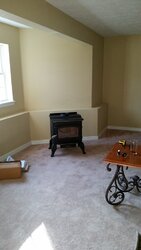Hey guys and gals
I've been lurking here for a little while, and finally decided to create an account and say hi... and ask some questions.
I'm from northeast Pennsylvania and recently moved into a new home. The home is about ten years old and is propane heated, and has a propane fireplace upstairs. It is a one story ranch with a full walk-in basement (so the back of the house is essentially two-story, and the front is one story, if that makes sense). The upstairs is about 2000 sqft, and about 1000 sqft of the basement is finished, and 1000 sqft is unfinished.
I am planning on putting in a wood stove in the main room of the finished basement area. It is one large room that is about 750 sqft. It is a long thin room (17' x 45'), and the wood stove would be placed on one side of the room against one of the short walls (so, about 45 feet from the other side).
My goal for the wood stove is really just to heat the one room of the finished portion of my basement. I would plan to close all heating vents from the propane furnace in this area so that it could be heated solely by the wood stove. I have an unlimited supply of free wood where I live, all I have to do is cut and split it, of course, so this will cut down on heating costs... But, in actuality, my main motivation for the wood stove is the ambiance of having one. I grew up with wood stoves, and love the smell, the look of the fire, and the unique heating that only comes from a wood fire.
I am looking at a wood stove from Tractor Supply Company, the Vogelzang Defender. It is on sale now for $509. It is rated for heating 1200 sqft 68,000 BTU. I know from lurking on here that the sqare footage and BTU estimations are often quite optimistic, so I'm hoping that a 1200 sqft stove will work well for this 750 sqft space. I'd rather have a stove I can run on "high" rather than a big one that I have to damper down. Plus, the price is good.
What do you guys think? Does anyone have any opinions on the stove? How about the size of the stove? Any other stove recommendations?
P.S. I know this is kind of silly, but the stove must be a "claw foot" stove. I absolutely love the look of a claw foot stove, as opposed to the pedestal types.
I've been lurking here for a little while, and finally decided to create an account and say hi... and ask some questions.
I'm from northeast Pennsylvania and recently moved into a new home. The home is about ten years old and is propane heated, and has a propane fireplace upstairs. It is a one story ranch with a full walk-in basement (so the back of the house is essentially two-story, and the front is one story, if that makes sense). The upstairs is about 2000 sqft, and about 1000 sqft of the basement is finished, and 1000 sqft is unfinished.
I am planning on putting in a wood stove in the main room of the finished basement area. It is one large room that is about 750 sqft. It is a long thin room (17' x 45'), and the wood stove would be placed on one side of the room against one of the short walls (so, about 45 feet from the other side).
My goal for the wood stove is really just to heat the one room of the finished portion of my basement. I would plan to close all heating vents from the propane furnace in this area so that it could be heated solely by the wood stove. I have an unlimited supply of free wood where I live, all I have to do is cut and split it, of course, so this will cut down on heating costs... But, in actuality, my main motivation for the wood stove is the ambiance of having one. I grew up with wood stoves, and love the smell, the look of the fire, and the unique heating that only comes from a wood fire.
I am looking at a wood stove from Tractor Supply Company, the Vogelzang Defender. It is on sale now for $509. It is rated for heating 1200 sqft 68,000 BTU. I know from lurking on here that the sqare footage and BTU estimations are often quite optimistic, so I'm hoping that a 1200 sqft stove will work well for this 750 sqft space. I'd rather have a stove I can run on "high" rather than a big one that I have to damper down. Plus, the price is good.
What do you guys think? Does anyone have any opinions on the stove? How about the size of the stove? Any other stove recommendations?
P.S. I know this is kind of silly, but the stove must be a "claw foot" stove. I absolutely love the look of a claw foot stove, as opposed to the pedestal types.


